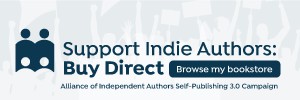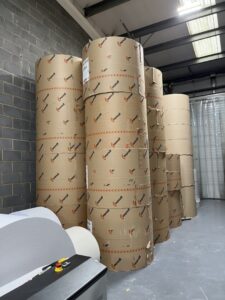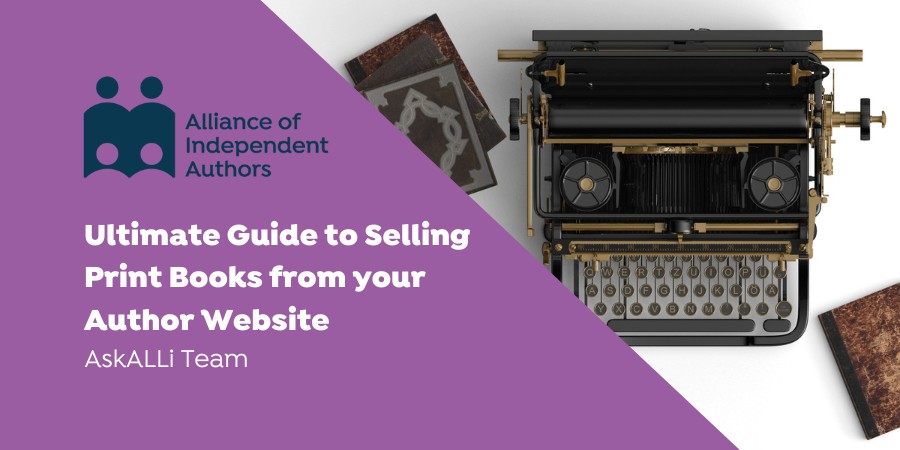Are you happy to sell ebooks and audiobooks direct from your author website but you balk at print? It may not be as complex as you think. Today the Alliance of Independent Authors brings you the ultimate guide to selling print books direct from your author website
ALLi lists direct sales as one of the drivers of Self-Publishing 3.0. In self-publishing 3.0, the influence and power are moving from big tech companies to creators such as independent authors like us. Thanks to this change, we have opportunity and the ability to successfully create our writing and publishing business today.
Self-publishing 3.0 gives us autonomy, control, and direct access to our readers. And selling direct is a manifestation of that.
What is Selling Direct?
Selling direct means using a platform that you own—be it your website or a digital store, for example a Shopify store—to sell your books and products directly to readers.
This is based on the advice Morgana Best gave indie authors on the Self-Publishing Podcast in 2018: “Own and develop your own real estate,” Morgana said. “Send readers to your own website or your own app – to anything you own.”
“Why build your empire on rented land?”
Why Sell Direct?
Selling direct in the past has faced a lot of resistance because of the time and the need to do the administration required around physical sales. The admin including printing and storing books, packaging, addressing, and posting etc.
But selling direct gives you more flexibility with what you can do. You can sign books, personalise them, add bookmarks and even send bundles of books when you sell direct.
In addition, technology is rapidly advancing and there are a plethora of services that enable you to sell direct from your website by connecting to their print on demand service. They will then pack, address, and ship the books out—though this does reduce your ability to sign and personalise the books.
There are many reasons you'd want to sell direct:
- Build a new revenue stream
- Be wide and non-exclusive with your books
- Have more flexibility over how and when you get paid
- Earn a higher % on each sale
- Have control over your customers' data
Why Sell Print Books Direct?
Perhaps you already sell your ebooks and/or audiobooks direct and believe print is not something you’d be interested in. You still know your customers, receive the money in a matter of days after the sale, and are growing your email list. Or perhaps your ebooks might be enrolled in an exclusivity contract deal, and print is not worth the hassle.
You need to approach selling print direct with an independent business mindset—how disheartening is it when you go into your favourite store to buy a shirt, but the one in your size is stocked elsewhere? Similarly, if a reader pulls up your author page to buy a large-print edition paperback of your latest book and only find the ebook, they will be disheartened. They had come looking for the product and the experience of buying from you.
Embrace Wide
Another driver of self-publishing 3.0 and a close pal of selling direct is ‘being wide’. Wide embraces non-exclusivity and takes your books everywhere: all stores, in as many territories as possible and in as many formats as possible.
If you’re wide and not tied to any exclusivity contract, why should you only exclusively sell ebooks and/or audiobooks on your author website? Today’s landscape is about independence—we can give our worldwide customers a choice of our books in different formats through our website. Shopping with us can be an experience for them: large-print, dyslexia format, paperback, hardback, special editions, bundles, signed copies, different covers—you have to try it and see if it works for you.
What Options do I Have to Sell Direct?
There are many print-on-demand services that work with independent authors in various capacities—some of them are print-on-demand service providers while others help authors handle formatting and warehousing. It is important to know what the boundaries of their services are. And whether what they offer is what you’re looking for. For eg: some services are assisted publishing services or small independent publishers while others are print-on-demand and distribution providers.
When vetting providers, please keep the following in mind, especially for print:
- Quality of the books: Even if you’ve outsourced your book production, your readers purchase the books on your store. That makes you responsible for delivering a quality product to them, especially if your book is heavily reliant on good quality eg: a special edition, art books, coffee-table books etc. Make sure you proof the print files well, and that the quality of the books is consistent no matter where or how they have been printed.
- Payments and Royalties: If the service provider’s website isn’t clear on the cost or any payments that you are expected to make, be wary of working with them. Make sure you know beforehand of any hidden or undetermined costs that you will have to bear. Do they have a setup fee? Or do they take a percentage on every sale? The service provider should also be transparent with their policies regarding royalties. How much of a percentage do you earn from each sale? What is the royalty payment cycle?
- Reporting: The service provider should report sales and royalties earned regularly. The reports should be accessible to you and show royalty calculation based on the number of sales.
- Returns Policy: Like when you use a POD service which ships to customers or bookstores, you will have to deal with a returns policy for your own store. Make sure you understand what the service provider’s policies regarding returns are and ensure they align with yours. You need to communicate this returns policy to your readers as well.
- Autonomy: Check what you can and can’t do. Can you make changes once the book is uploaded? If you use a plugin for this service on your website, can you brand the sales page like you want it to? Does it allow you to price your books, design the sales page in a way that aligns with your brand? Think about what your vision is for your website and if this provider allows you the freedom you would need to set up something similar to what you wanted.
- Rights: It is very important for you to know how much control and autonomy you maintain when using their services. Please read the fine print. Who owns the files after publication? Are you signing away a part of your rights to them? Can they tweak your book without your permission? Be aware that you own the copyright to your book, so you should license it advantageously.
- Distribution: If it isn’t mentioned on the service provider’s website, ask them where they distribute print books. Which geographical area do they distribute to? Don’t sign up with a service which doesn’t service the areas where your primary audience is.
You could look these services up online and/or ask indie author groups. Don't forget: if you're a member of ALLi you can use our partner directory to check for providers. Log into the member site, navigate to APPROVED SERVICES.
Before you opt for a particular service provider, please check their terms and conditions as well.
- Think about: the cost and profit, territories, formats, rights, termination of the contract, obligations (standards for performance)
- Be in control
- Keep an open mind
- Seek help
Beware of:
- Too high or too low fees as compared to other similar services
- Most service providers should focus on readers, not the authors
- All-encompassing packages with vague descriptions and unrealistic promises
What should I consider before I Sell Print Books Direct?
As with any new income stream, when you sell your print books on your author website, it’s a way to connect with your readers and share what your publishing values are. You should prioritise your reader and create an experience for them.
So have a think about:
How will you market your direct print sales? You can offer reader magnets, special discounts, or exclusive content to your readers—similar to what you would do with ebooks or audiobooks. Don’t forget to explain to the readers already on your email list how it is beneficial for you if they purchased books from your website directly. Get creative about marketing your print books to readers. Think about how you can give them an experience that aligns with your values and brand.
NOTE ABOUT MARKETING:
Your email list is important to build connection with your readers. And it is where you should go to look for the initial print book customers. That doesn’t mean each email you send to them should say, ‘buy my books’. But these readers know you and are interested in supporting you. If you tell them you’re now selling print on your website, they are willing to support you. You can offer them discounts, exclusive print editions and strengthen your communication with them. Based on what they purchased, you can also segment your audience and know whom to reach out to next time you have a book out in a certain series.
How will you protect your customers' data? Make sure you only ask for necessary data from your readers and have their consent before you use it. Think about how you can store the data safely, create ethical policies about readers’ information, and have a privacy policy.
What is your returns policy? You need to think about your returns and how you plan to handle them. When you choose a printing service for your books, check what their policies are. Can you decide whether you allow returns or not? How do they handle returns? Do they charge you? How efficient and helpful is their customer service team?
How will you handle customer service? Sometimes there are issues with the books that are shipped to your readers. Who do your readers get in touch with in that case? Does the printing service you have a contract with offer this help? Will they charge you for re-shipping or exchanging the book? In case of any issues, make sure you offer help and guidance to your readers.
How does tax work? Tax is a very individualistic topic that depends on where you are selling from and who you are selling to. When you select a service and a payment gateway, make sure you understand how they handle taxes. Will they do it for you? Or will you have to handle some of the taxes yourself? Taxes are not only restrictive to print sales. So, it will help you to understand them if you sell anything on your website.
Navigating Through These Choices
With all these questions and options to get started with, you might feel lost in the wilderness. When overwhelmed or unsure, it’s always a good idea to reach back for your writing and publishing values. What is the purpose of this author-business? What are your goals? The answers to these questions will help you navigate through choices. You’ll know whether to stock inventory and ship each book or if you should outsource printing and logistics to a third party entirely. There can be a lot of variations to this choice, and ALLi’s member directory has a service that suits each answer.
You should also consider the cost vs the benefit of your decisions. How much time and effort do you want to put into selling your print books? And what benefits does that give you? These benefits might not be just monetary. Selling print books might help you reach your readers in a way you couldn’t before. It might give a boost to your ebook and audiobook sales.
When choosing between what you’d like to do vs what you should do, think ‘balance’. Find a balance between costs and benefits, ‘must-dos’ vs your values, ‘want to’ vs costs. And that will help you progress in this journey.
It might seem overwhelming when listed out this way, but you only have to make these decisions when initially setting up shop. After that, a few tweaks based on the things you learn will help you build a great author-business over time.
 We also offer our memberss badges that can be embedded on your website to encourage readers to buy directly from you, rather than at other online retail stores.
We also offer our memberss badges that can be embedded on your website to encourage readers to buy directly from you, rather than at other online retail stores.Sacha Black Visits BookVault

Sacha Black, Author and ALLi Blog Manager
Sacha Black recently visited Bookvault's warehouse and asked them about how indie authors can sell direct with them. BookVAULT is an Alliance of Independent Authors partner member: a print on demand solution brought to you by digital book and journal printers, printondemand-worldwide.

Printing Machine
What are your recommendations to indie authors for selling print books direct?
If you don’t already have a website setup, we recommend Shopify, as the simplest and most user-friendly solution. If you already have a blog or website setup through WordPress, Woo Commerce is a great option as it’ll plug directly into your existing store and allow direct print sales using the Bookvault plugin.
Other e-commerce softwares can be used, but often lack functionality and require a little bit more work.
Equally Kickstarter is a great way to launch your book. Once your campaign has finished, you can reach out to our team who will help you import all the orders as bulk to save you manually creating shipping labels and packaging them up!
Any tips or advice for indies on selling print books direct?
- A free novella/sample of your book (an ebook) works great for attracting new customers and growing your mailing list. If you put the product as free, customers still have to go through the checkout process (capturing data) which you can use for future marketing.

hardback books piled up ready to be glued together
- Selling special editions is a great way to attract users to your store over Amazon. Simple things such as an exclusive hardback edition or bonus colour illustrations help people choose to buy direct over going to the big giants like Amazon.
- Exclusive releases also help drive sales, when you launch a new title, make it live direct for the first couple of weeks exclusively on your site, trying to direct eager customers to your site, earning you more!
- Selling bundles at a promotional discount helps bring up the average sales price on your store from that of one book to several, and in turn increases profits.
What else can you do for indie authors?

Stacks of mile-long reams of printing paper
We offer a few options. For example, single book printing so you only print when you need it, dispatching books in some cases same day. We have a free live chat service with pretty much instant responses during business hours and a 1-working day response time to emails.
We can also print any size from A6 (105 x 148.5 mm) to 297mm x 297mm including landscape products, and bespoke options such as foil embossing as well as printed jackets on both printed and cloth PPC bindings.
We have range of bindings for all kinds of projects:
- Saddle stitched
- Wiro
- Spiral
- Printed Casebound
- Case Cloth
- Paperback
We offer affordable colour printing, printed on premium paper allowing for once impossible products through POD such as children’s books. We do this through split colour, where we only charge you for the number of colour pages in your book, meaning you can make it extra special.
What do you wish indie authors knew about selling direct?
You can use multiple printers together for a wide approach. Don’t just limit yourself to one provider.
And don't forget, if you're an Alliance of independent member there are often discounts and deals for many providers—including us. We provide ALLi members a promo code for five free titles each month. (log in to the member zone to avail of your discount).
ALLi Member Case Study: Morgana Best
What are the circumstances under which indie authors should consider setting up a website print store?
You should set up your store right from the start. It’s important to set up selling print from the very beginning. As soon as an author has an ebook, it’s a good idea to release it in print–and you can release it in paperback, large print, dyslexia friendly, and hardcover. Print book box sets or bundles also do well when selling direct.
What are the biggest mindset shifts to make when creating your print direct store?
Selling direct is absolutely nothing like selling on the retailers. For a start, it’s a business and should be treated as a business. Email lists and Facebook ads are nothing like the ones authors use for selling on the retailers.
When selling on the retailers, authors cannot use Facebook Sales (used to be called Conversion) ads because they do not control or own the retailer’s pixel. That is why authors selling on the retailers have to use Traffic ads which ecommerce stores should not use. Sales ads are not available to them.
And why does this matter?
There are many reasons but the main one is that when somebody runs a Traffic ad, Facebook does its utmost to find clickers. Of course, some of these clickers will also buy, but Facebook is simply looking for people who will click on the ad. On the other hand, when you run a Sales ad, Facebook is actually looking for buyers and not for people who will click.
The way you treat targeting is also different, and there are also stages of ads. Facebook ads for selling direct are a whole different ball game.
Newsletter lists are also different for ecommerce.
Also, I’ve noticed that some authors are reluctant to spend $10 in order to make $100 and would rather have a storefront that is free simply because it doesn’t cost them anything, thereby neglecting the fact that they could be making serious money with a decent storefront. As I said, it’s a business.
Please keep in mind that even if Facebook Ads are an excellent way to reach readers, you should be mindful of how they work and the amount of money you can spend on ads, especially if you're a first-time or emerging author.
What do you say to those authors worried about print and shipping costs for global distribution and not making enough profit to support the endeavour?
I would say those authors have it completely wrong. The author does not ship the books in person. The author does not pay the shipping. There is no upfront cost when using a third-party consignment printer that will ship for you. And after the printing costs, everything is profit.
Any advice to help authors start shifting/training their audience to direct?
It’s most important to note that customers do not need to be trained to buy direct. Stores make billions upon billions and do not train people to buy direct from them.
Training the audience is author-selling-on-retailer thinking. Authors are so used to Amazon and the other retailers that they assume their readers need to be trained to buy from them. This is actually not the case.
To get their current readers to an author store, the author simply has to send a coupon code or a book on sale to their current newsletter list. There are plenty of readers out there who are already buying direct and will think nothing of buying books direct.
Authors need to set their third-party retailer mindset aside when selling direct. Books are not magical unicorns. Books are simply products.
How do you send traffic to your webstore?
You can have free stores on social media–Facebook, Instagram, TikTok, Pinterest, even Google.
The main way to send traffic is to do what all the successful ecommerce stores do and run Facebook ads–again, not Traffic ads but Sales ads (and Sales ads are not available to authors selling on retailers).
What mistakes do you see authors making with print direct?
I started out with print back in the day, and over the years, I have seen authors think of print as an aside and not treat it properly. Authors often tend to concentrate on ebooks or audiobooks and neglect print.
However, there is good money to be made with print.
Another mistake is to price something lower than on the retailers. I’m always telling people to forget about Amazon–don’t make your ebooks a lower price for example.
If you are using your own printer, you can sell your print books for less due to the lower printing costs, and that’s great, but don’t do it simply because you wish to price lower than Amazon. Put Amazon out of your head.
It’s also a good idea to offer a standard discount with a pop-up subscriber form which appears a set time after somebody lands on your store. By the way, the wording and timing are both super important here.
You can do a joint email and SMS marketing subscriber pop-up.
Authors like to give away freebies, but it’s not a good idea for an ecommerce store. Instead of a lead magnet such as a free novella or whatever, use a discount code for a subscriber instead.
Now what are some fun ideas you can do with print direct?
You can bundle print books and offer say, the first 10 books in the series, or if you have a 9 book series or even a 7 or 16 book series offer that as a bundle.
With selling direct, it’s important to have a higher average order value. If a customer only buys a single book from an author store, that would be only around $5 to $10. Yet it costs as much to advertise a $5 book as it does to advertise a $50 or even a $100 product. That is why with the store it’s super important to increase the average order value.
An easy way to do this is with bundles. You could bundle a print book, ebook, and audiobook or you could offer the next few print books in the series.
At the checkout page, which has a 100% open rate, you could and should do an upsell, such as to a print book bundle.
Non-fiction authors and low/no content authors can sell spiral bound books in their stores.
Is there a difference in methods/process for international vs national shipping?
There is no difference in the method or process for international vs. national shipping. My printer ships worldwide. Again, authors often bring up the fact that customers with Prime can have their Amazon books shipped for free.
Once more, I say to forget that. Plenty of online businesses sell products that are also sold from Amazon with free shipping. My advice is to put that out of your mind completely. Don’t even give it another thought.
Nobody can compete with Amazon so don’t even bother to try. Plenty of people buy print books from authors directly. There’s very good money in it.
Any other tips or advice?
Don’t treat print as a poor cousin. I often hear authors say that they don’t sell much print, and when I ask them if they have done anything to promote it, the answer is invariably no.
It costs nothing to set up print with a third-party printer, so that everything after printing cost is profit.
Morgana Best, USA Today Bestselling Author
Morgana Best started selling print direct in 1993. She sold on the retailers after Kindle was released, but when she stopped to consider who benefited most from her hard work, she focused on selling direct. Morgana teaches authors how to sell from their own stores with her book and course, Stop Making Others Rich. Find out more about Morgana on her website.





